Knowledge Management - Infosys Case Study
VerifiedAdded on 2023/06/04
|10
|2466
|59
AI Summary
This report focuses on the knowledge management growth that Infosys went through and the challenges it had to face in implementing the knowledge management base in the firm itself. The report highlights the key issues and challenges faced by Infosys, theories to address the issue, implementation and action plan strategies, and more.
Contribute Materials
Your contribution can guide someone’s learning journey. Share your
documents today.
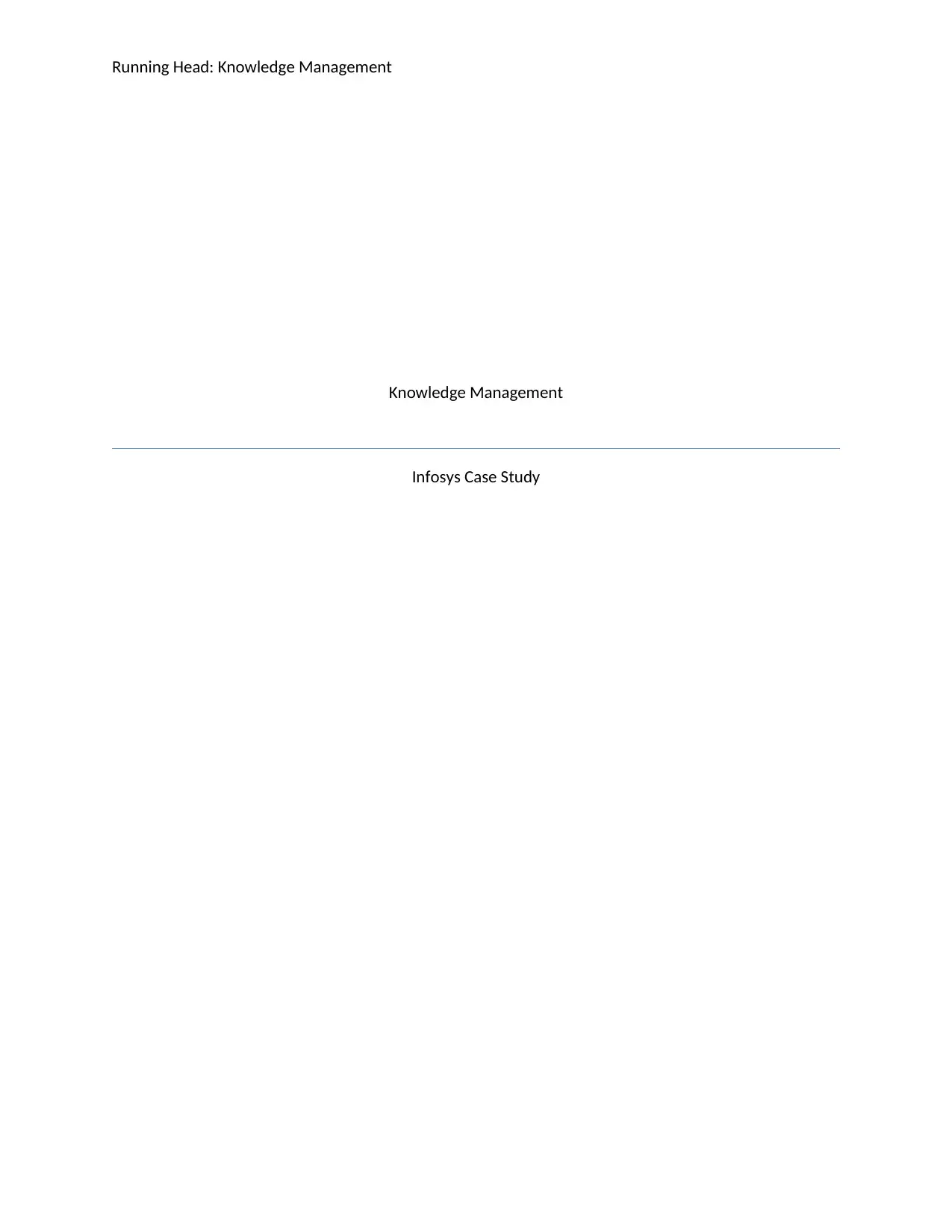
Running Head: Knowledge Management
Knowledge Management
Infosys Case Study
Knowledge Management
Infosys Case Study
Secure Best Marks with AI Grader
Need help grading? Try our AI Grader for instant feedback on your assignments.
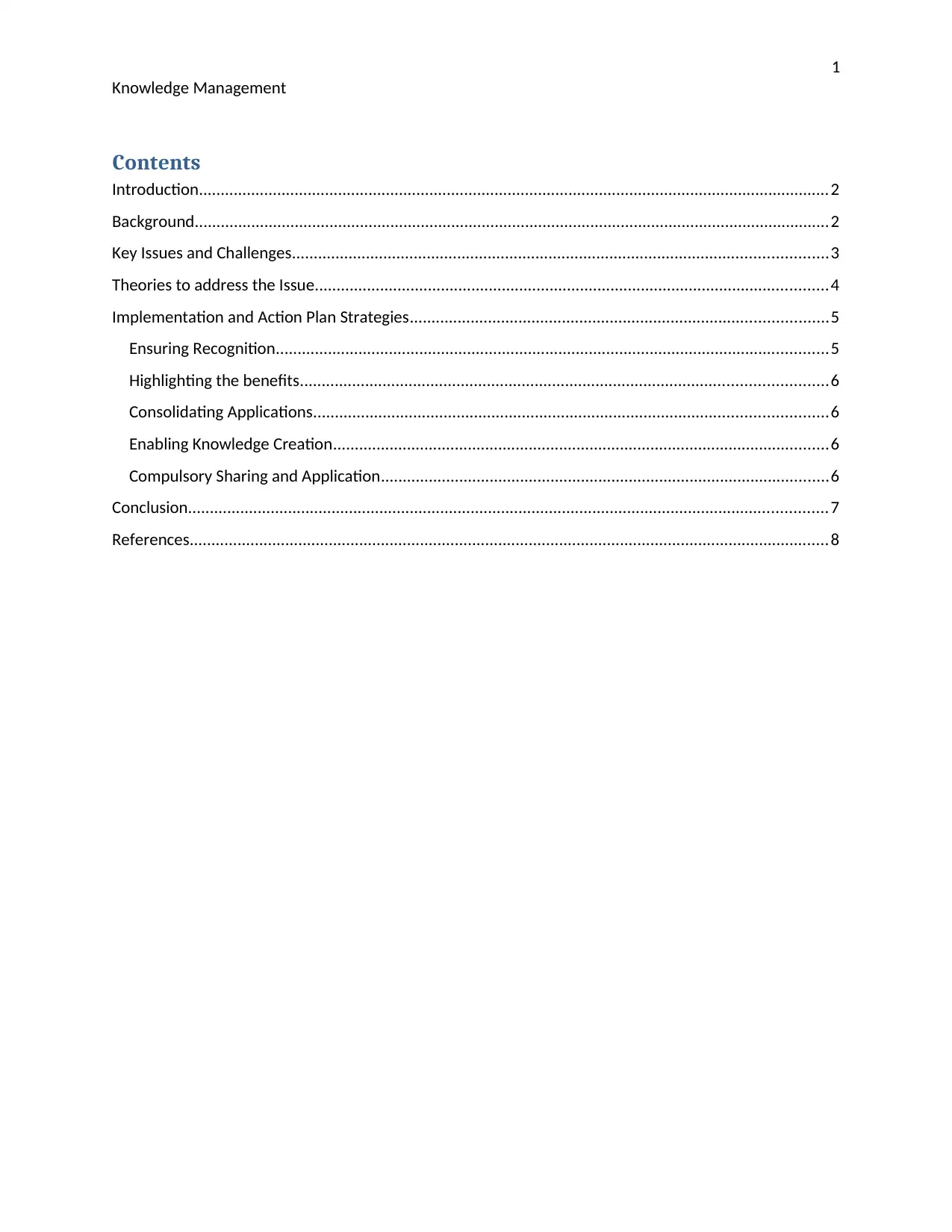
1
Knowledge Management
Contents
Introduction.................................................................................................................................................2
Background..................................................................................................................................................2
Key Issues and Challenges...........................................................................................................................3
Theories to address the Issue......................................................................................................................4
Implementation and Action Plan Strategies................................................................................................5
Ensuring Recognition...............................................................................................................................5
Highlighting the benefits.........................................................................................................................6
Consolidating Applications......................................................................................................................6
Enabling Knowledge Creation..................................................................................................................6
Compulsory Sharing and Application.......................................................................................................6
Conclusion...................................................................................................................................................7
References...................................................................................................................................................8
Knowledge Management
Contents
Introduction.................................................................................................................................................2
Background..................................................................................................................................................2
Key Issues and Challenges...........................................................................................................................3
Theories to address the Issue......................................................................................................................4
Implementation and Action Plan Strategies................................................................................................5
Ensuring Recognition...............................................................................................................................5
Highlighting the benefits.........................................................................................................................6
Consolidating Applications......................................................................................................................6
Enabling Knowledge Creation..................................................................................................................6
Compulsory Sharing and Application.......................................................................................................6
Conclusion...................................................................................................................................................7
References...................................................................................................................................................8
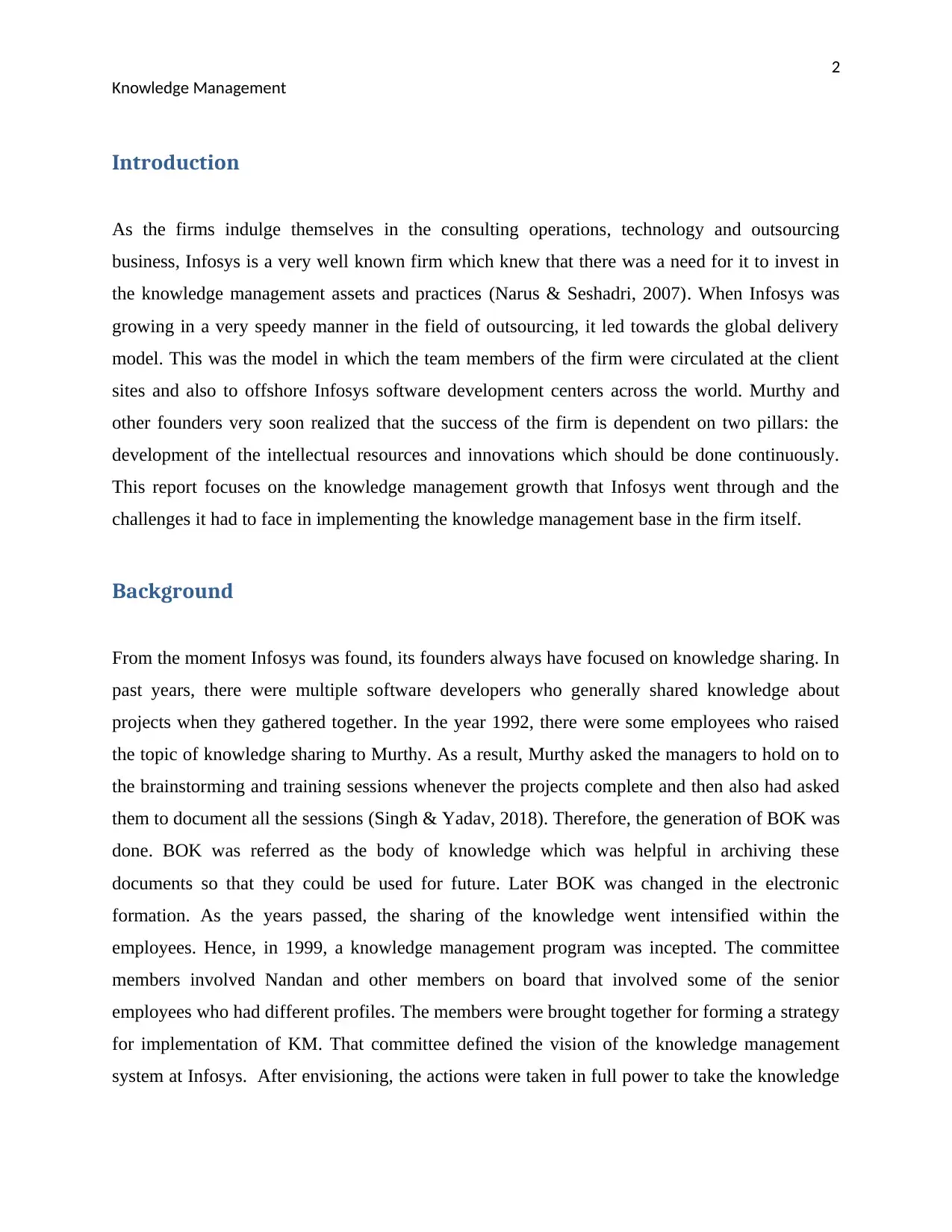
2
Knowledge Management
Introduction
As the firms indulge themselves in the consulting operations, technology and outsourcing
business, Infosys is a very well known firm which knew that there was a need for it to invest in
the knowledge management assets and practices (Narus & Seshadri, 2007). When Infosys was
growing in a very speedy manner in the field of outsourcing, it led towards the global delivery
model. This was the model in which the team members of the firm were circulated at the client
sites and also to offshore Infosys software development centers across the world. Murthy and
other founders very soon realized that the success of the firm is dependent on two pillars: the
development of the intellectual resources and innovations which should be done continuously.
This report focuses on the knowledge management growth that Infosys went through and the
challenges it had to face in implementing the knowledge management base in the firm itself.
Background
From the moment Infosys was found, its founders always have focused on knowledge sharing. In
past years, there were multiple software developers who generally shared knowledge about
projects when they gathered together. In the year 1992, there were some employees who raised
the topic of knowledge sharing to Murthy. As a result, Murthy asked the managers to hold on to
the brainstorming and training sessions whenever the projects complete and then also had asked
them to document all the sessions (Singh & Yadav, 2018). Therefore, the generation of BOK was
done. BOK was referred as the body of knowledge which was helpful in archiving these
documents so that they could be used for future. Later BOK was changed in the electronic
formation. As the years passed, the sharing of the knowledge went intensified within the
employees. Hence, in 1999, a knowledge management program was incepted. The committee
members involved Nandan and other members on board that involved some of the senior
employees who had different profiles. The members were brought together for forming a strategy
for implementation of KM. That committee defined the vision of the knowledge management
system at Infosys. After envisioning, the actions were taken in full power to take the knowledge
Knowledge Management
Introduction
As the firms indulge themselves in the consulting operations, technology and outsourcing
business, Infosys is a very well known firm which knew that there was a need for it to invest in
the knowledge management assets and practices (Narus & Seshadri, 2007). When Infosys was
growing in a very speedy manner in the field of outsourcing, it led towards the global delivery
model. This was the model in which the team members of the firm were circulated at the client
sites and also to offshore Infosys software development centers across the world. Murthy and
other founders very soon realized that the success of the firm is dependent on two pillars: the
development of the intellectual resources and innovations which should be done continuously.
This report focuses on the knowledge management growth that Infosys went through and the
challenges it had to face in implementing the knowledge management base in the firm itself.
Background
From the moment Infosys was found, its founders always have focused on knowledge sharing. In
past years, there were multiple software developers who generally shared knowledge about
projects when they gathered together. In the year 1992, there were some employees who raised
the topic of knowledge sharing to Murthy. As a result, Murthy asked the managers to hold on to
the brainstorming and training sessions whenever the projects complete and then also had asked
them to document all the sessions (Singh & Yadav, 2018). Therefore, the generation of BOK was
done. BOK was referred as the body of knowledge which was helpful in archiving these
documents so that they could be used for future. Later BOK was changed in the electronic
formation. As the years passed, the sharing of the knowledge went intensified within the
employees. Hence, in 1999, a knowledge management program was incepted. The committee
members involved Nandan and other members on board that involved some of the senior
employees who had different profiles. The members were brought together for forming a strategy
for implementation of KM. That committee defined the vision of the knowledge management
system at Infosys. After envisioning, the actions were taken in full power to take the knowledge
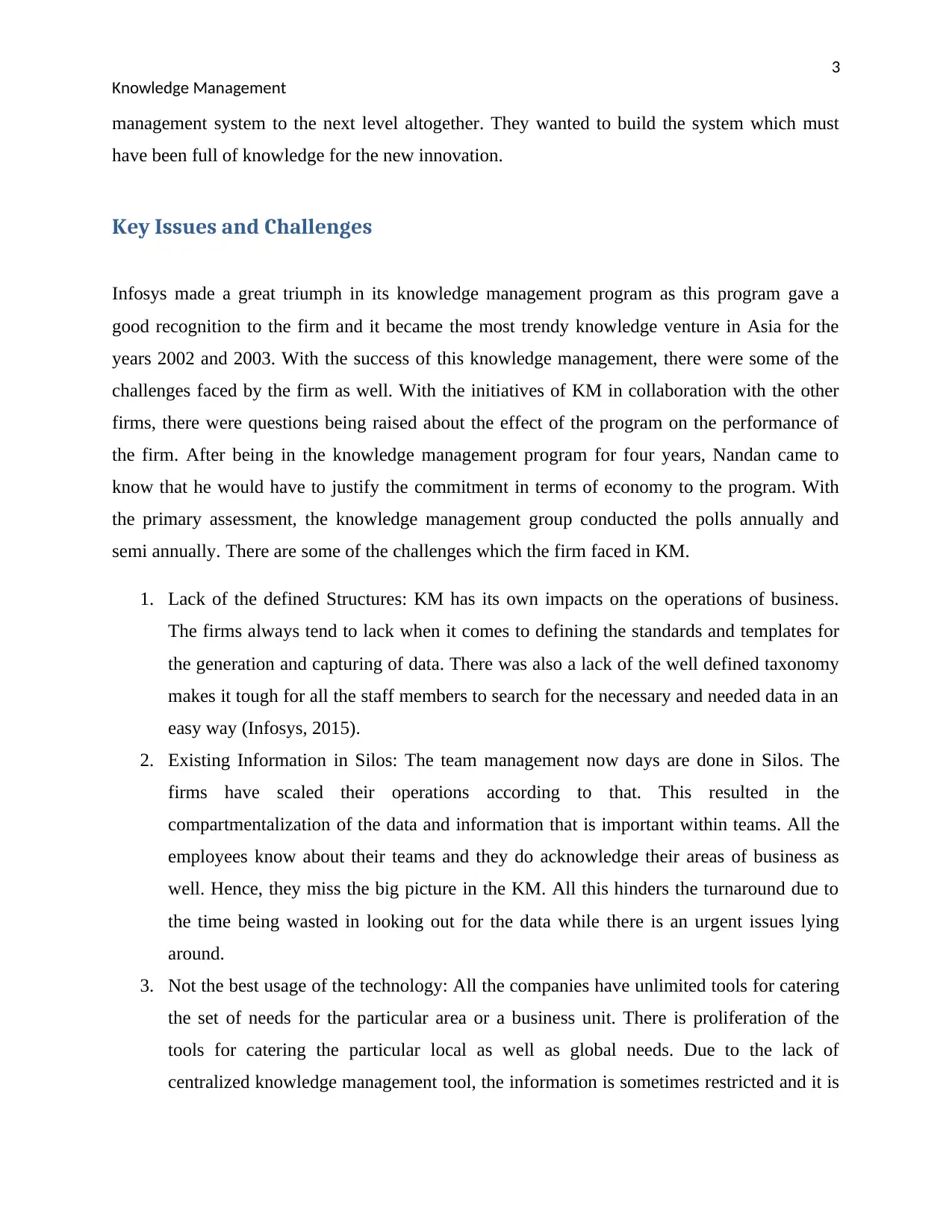
3
Knowledge Management
management system to the next level altogether. They wanted to build the system which must
have been full of knowledge for the new innovation.
Key Issues and Challenges
Infosys made a great triumph in its knowledge management program as this program gave a
good recognition to the firm and it became the most trendy knowledge venture in Asia for the
years 2002 and 2003. With the success of this knowledge management, there were some of the
challenges faced by the firm as well. With the initiatives of KM in collaboration with the other
firms, there were questions being raised about the effect of the program on the performance of
the firm. After being in the knowledge management program for four years, Nandan came to
know that he would have to justify the commitment in terms of economy to the program. With
the primary assessment, the knowledge management group conducted the polls annually and
semi annually. There are some of the challenges which the firm faced in KM.
1. Lack of the defined Structures: KM has its own impacts on the operations of business.
The firms always tend to lack when it comes to defining the standards and templates for
the generation and capturing of data. There was also a lack of the well defined taxonomy
makes it tough for all the staff members to search for the necessary and needed data in an
easy way (Infosys, 2015).
2. Existing Information in Silos: The team management now days are done in Silos. The
firms have scaled their operations according to that. This resulted in the
compartmentalization of the data and information that is important within teams. All the
employees know about their teams and they do acknowledge their areas of business as
well. Hence, they miss the big picture in the KM. All this hinders the turnaround due to
the time being wasted in looking out for the data while there is an urgent issues lying
around.
3. Not the best usage of the technology: All the companies have unlimited tools for catering
the set of needs for the particular area or a business unit. There is proliferation of the
tools for catering the particular local as well as global needs. Due to the lack of
centralized knowledge management tool, the information is sometimes restricted and it is
Knowledge Management
management system to the next level altogether. They wanted to build the system which must
have been full of knowledge for the new innovation.
Key Issues and Challenges
Infosys made a great triumph in its knowledge management program as this program gave a
good recognition to the firm and it became the most trendy knowledge venture in Asia for the
years 2002 and 2003. With the success of this knowledge management, there were some of the
challenges faced by the firm as well. With the initiatives of KM in collaboration with the other
firms, there were questions being raised about the effect of the program on the performance of
the firm. After being in the knowledge management program for four years, Nandan came to
know that he would have to justify the commitment in terms of economy to the program. With
the primary assessment, the knowledge management group conducted the polls annually and
semi annually. There are some of the challenges which the firm faced in KM.
1. Lack of the defined Structures: KM has its own impacts on the operations of business.
The firms always tend to lack when it comes to defining the standards and templates for
the generation and capturing of data. There was also a lack of the well defined taxonomy
makes it tough for all the staff members to search for the necessary and needed data in an
easy way (Infosys, 2015).
2. Existing Information in Silos: The team management now days are done in Silos. The
firms have scaled their operations according to that. This resulted in the
compartmentalization of the data and information that is important within teams. All the
employees know about their teams and they do acknowledge their areas of business as
well. Hence, they miss the big picture in the KM. All this hinders the turnaround due to
the time being wasted in looking out for the data while there is an urgent issues lying
around.
3. Not the best usage of the technology: All the companies have unlimited tools for catering
the set of needs for the particular area or a business unit. There is proliferation of the
tools for catering the particular local as well as global needs. Due to the lack of
centralized knowledge management tool, the information is sometimes restricted and it is
Secure Best Marks with AI Grader
Need help grading? Try our AI Grader for instant feedback on your assignments.
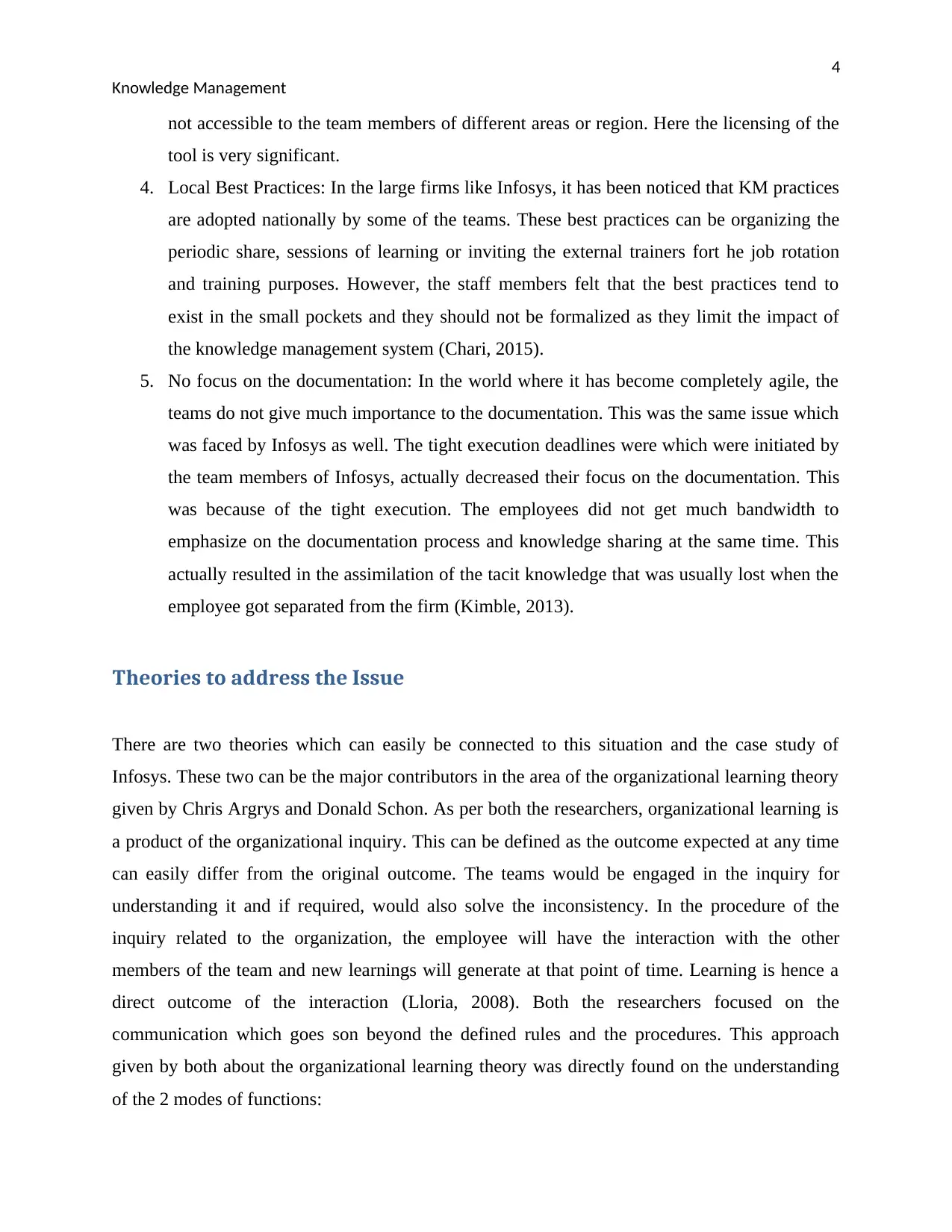
4
Knowledge Management
not accessible to the team members of different areas or region. Here the licensing of the
tool is very significant.
4. Local Best Practices: In the large firms like Infosys, it has been noticed that KM practices
are adopted nationally by some of the teams. These best practices can be organizing the
periodic share, sessions of learning or inviting the external trainers fort he job rotation
and training purposes. However, the staff members felt that the best practices tend to
exist in the small pockets and they should not be formalized as they limit the impact of
the knowledge management system (Chari, 2015).
5. No focus on the documentation: In the world where it has become completely agile, the
teams do not give much importance to the documentation. This was the same issue which
was faced by Infosys as well. The tight execution deadlines were which were initiated by
the team members of Infosys, actually decreased their focus on the documentation. This
was because of the tight execution. The employees did not get much bandwidth to
emphasize on the documentation process and knowledge sharing at the same time. This
actually resulted in the assimilation of the tacit knowledge that was usually lost when the
employee got separated from the firm (Kimble, 2013).
Theories to address the Issue
There are two theories which can easily be connected to this situation and the case study of
Infosys. These two can be the major contributors in the area of the organizational learning theory
given by Chris Argrys and Donald Schon. As per both the researchers, organizational learning is
a product of the organizational inquiry. This can be defined as the outcome expected at any time
can easily differ from the original outcome. The teams would be engaged in the inquiry for
understanding it and if required, would also solve the inconsistency. In the procedure of the
inquiry related to the organization, the employee will have the interaction with the other
members of the team and new learnings will generate at that point of time. Learning is hence a
direct outcome of the interaction (Lloria, 2008). Both the researchers focused on the
communication which goes son beyond the defined rules and the procedures. This approach
given by both about the organizational learning theory was directly found on the understanding
of the 2 modes of functions:
Knowledge Management
not accessible to the team members of different areas or region. Here the licensing of the
tool is very significant.
4. Local Best Practices: In the large firms like Infosys, it has been noticed that KM practices
are adopted nationally by some of the teams. These best practices can be organizing the
periodic share, sessions of learning or inviting the external trainers fort he job rotation
and training purposes. However, the staff members felt that the best practices tend to
exist in the small pockets and they should not be formalized as they limit the impact of
the knowledge management system (Chari, 2015).
5. No focus on the documentation: In the world where it has become completely agile, the
teams do not give much importance to the documentation. This was the same issue which
was faced by Infosys as well. The tight execution deadlines were which were initiated by
the team members of Infosys, actually decreased their focus on the documentation. This
was because of the tight execution. The employees did not get much bandwidth to
emphasize on the documentation process and knowledge sharing at the same time. This
actually resulted in the assimilation of the tacit knowledge that was usually lost when the
employee got separated from the firm (Kimble, 2013).
Theories to address the Issue
There are two theories which can easily be connected to this situation and the case study of
Infosys. These two can be the major contributors in the area of the organizational learning theory
given by Chris Argrys and Donald Schon. As per both the researchers, organizational learning is
a product of the organizational inquiry. This can be defined as the outcome expected at any time
can easily differ from the original outcome. The teams would be engaged in the inquiry for
understanding it and if required, would also solve the inconsistency. In the procedure of the
inquiry related to the organization, the employee will have the interaction with the other
members of the team and new learnings will generate at that point of time. Learning is hence a
direct outcome of the interaction (Lloria, 2008). Both the researchers focused on the
communication which goes son beyond the defined rules and the procedures. This approach
given by both about the organizational learning theory was directly found on the understanding
of the 2 modes of functions:
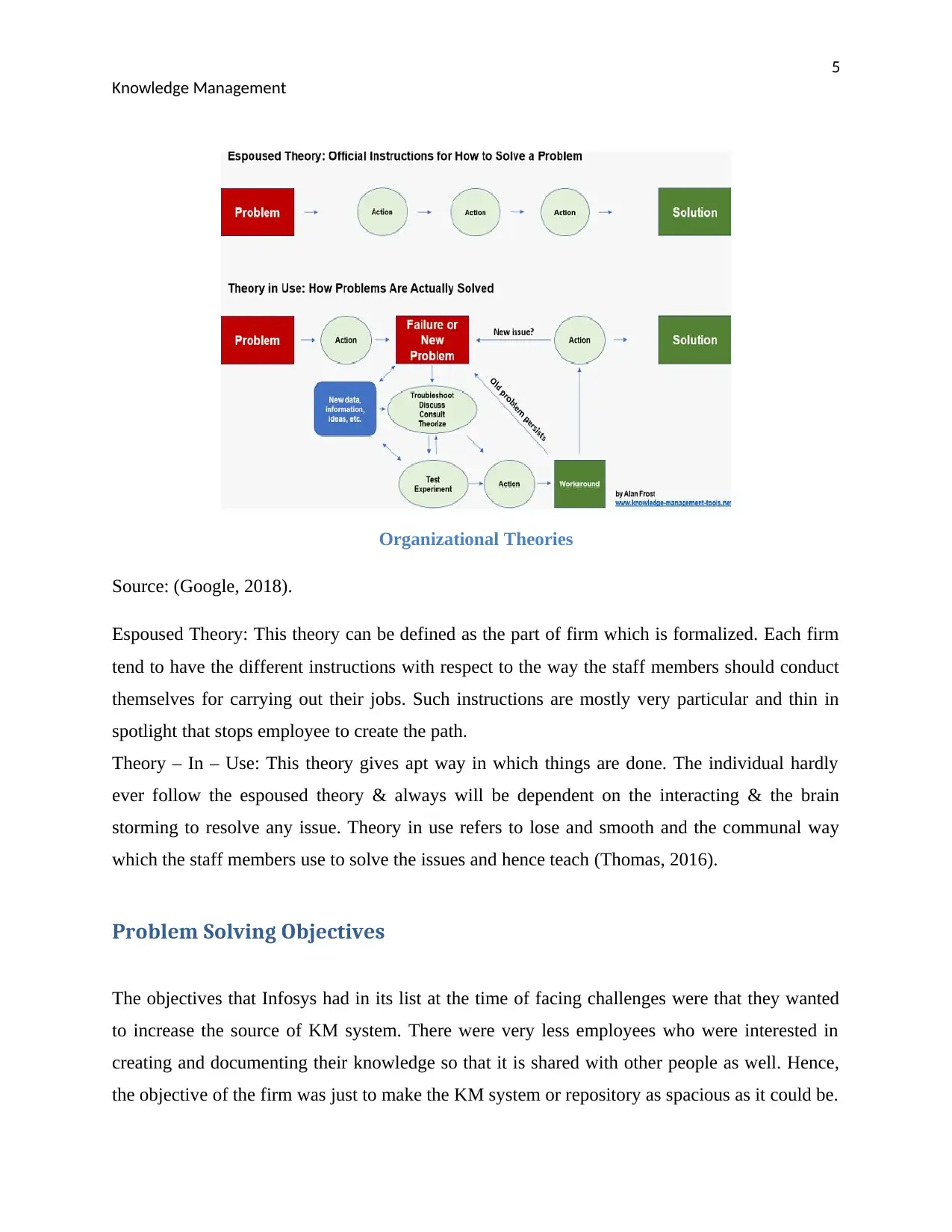
5
Knowledge Management
Organizational Theories
Source: (Google, 2018).
Espoused Theory: This theory can be defined as the part of firm which is formalized. Each firm
tend to have the different instructions with respect to the way the staff members should conduct
themselves for carrying out their jobs. Such instructions are mostly very particular and thin in
spotlight that stops employee to create the path.
Theory – In – Use: This theory gives apt way in which things are done. The individual hardly
ever follow the espoused theory & always will be dependent on the interacting & the brain
storming to resolve any issue. Theory in use refers to lose and smooth and the communal way
which the staff members use to solve the issues and hence teach (Thomas, 2016).
Problem Solving Objectives
The objectives that Infosys had in its list at the time of facing challenges were that they wanted
to increase the source of KM system. There were very less employees who were interested in
creating and documenting their knowledge so that it is shared with other people as well. Hence,
the objective of the firm was just to make the KM system or repository as spacious as it could be.
Knowledge Management
Organizational Theories
Source: (Google, 2018).
Espoused Theory: This theory can be defined as the part of firm which is formalized. Each firm
tend to have the different instructions with respect to the way the staff members should conduct
themselves for carrying out their jobs. Such instructions are mostly very particular and thin in
spotlight that stops employee to create the path.
Theory – In – Use: This theory gives apt way in which things are done. The individual hardly
ever follow the espoused theory & always will be dependent on the interacting & the brain
storming to resolve any issue. Theory in use refers to lose and smooth and the communal way
which the staff members use to solve the issues and hence teach (Thomas, 2016).
Problem Solving Objectives
The objectives that Infosys had in its list at the time of facing challenges were that they wanted
to increase the source of KM system. There were very less employees who were interested in
creating and documenting their knowledge so that it is shared with other people as well. Hence,
the objective of the firm was just to make the KM system or repository as spacious as it could be.
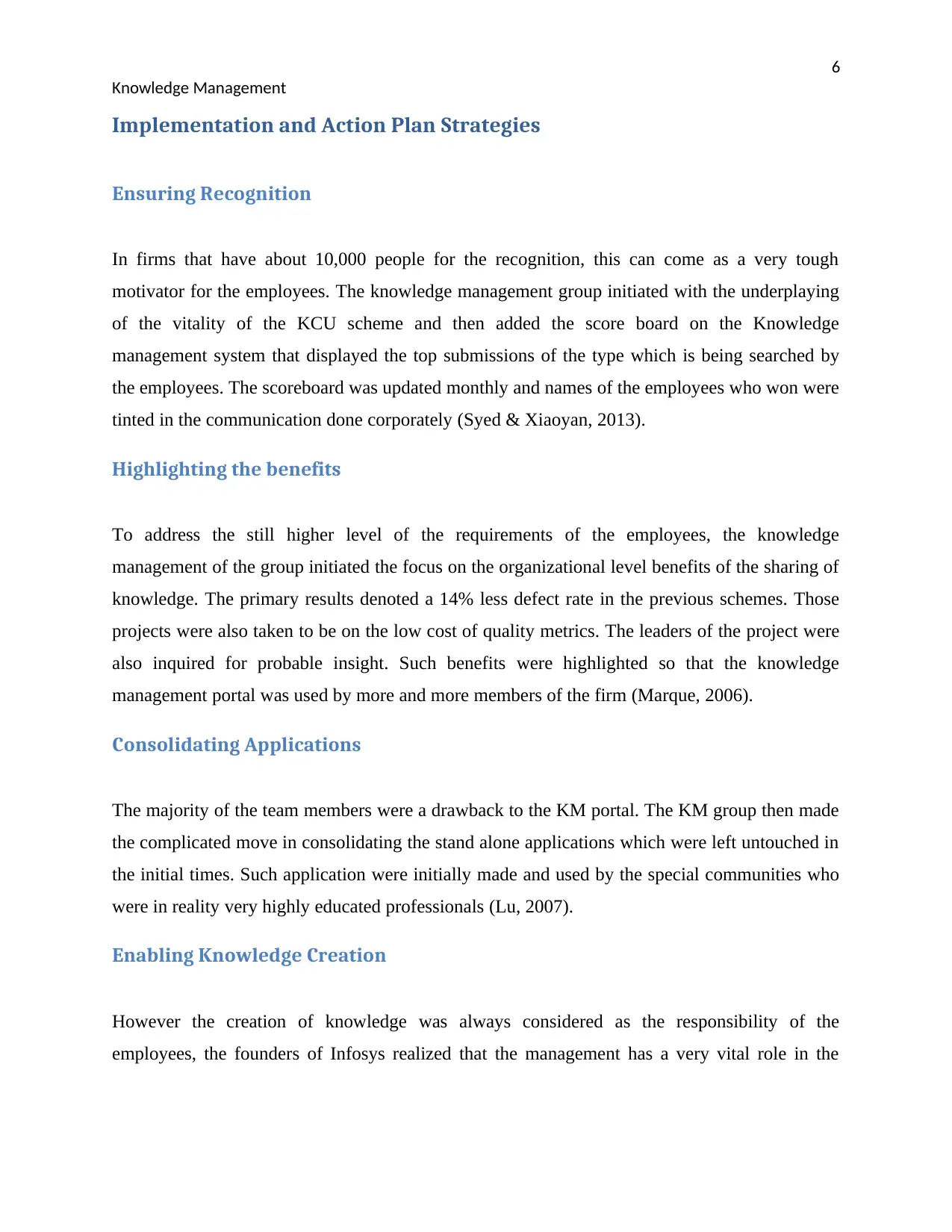
6
Knowledge Management
Implementation and Action Plan Strategies
Ensuring Recognition
In firms that have about 10,000 people for the recognition, this can come as a very tough
motivator for the employees. The knowledge management group initiated with the underplaying
of the vitality of the KCU scheme and then added the score board on the Knowledge
management system that displayed the top submissions of the type which is being searched by
the employees. The scoreboard was updated monthly and names of the employees who won were
tinted in the communication done corporately (Syed & Xiaoyan, 2013).
Highlighting the benefits
To address the still higher level of the requirements of the employees, the knowledge
management of the group initiated the focus on the organizational level benefits of the sharing of
knowledge. The primary results denoted a 14% less defect rate in the previous schemes. Those
projects were also taken to be on the low cost of quality metrics. The leaders of the project were
also inquired for probable insight. Such benefits were highlighted so that the knowledge
management portal was used by more and more members of the firm (Marque, 2006).
Consolidating Applications
The majority of the team members were a drawback to the KM portal. The KM group then made
the complicated move in consolidating the stand alone applications which were left untouched in
the initial times. Such application were initially made and used by the special communities who
were in reality very highly educated professionals (Lu, 2007).
Enabling Knowledge Creation
However the creation of knowledge was always considered as the responsibility of the
employees, the founders of Infosys realized that the management has a very vital role in the
Knowledge Management
Implementation and Action Plan Strategies
Ensuring Recognition
In firms that have about 10,000 people for the recognition, this can come as a very tough
motivator for the employees. The knowledge management group initiated with the underplaying
of the vitality of the KCU scheme and then added the score board on the Knowledge
management system that displayed the top submissions of the type which is being searched by
the employees. The scoreboard was updated monthly and names of the employees who won were
tinted in the communication done corporately (Syed & Xiaoyan, 2013).
Highlighting the benefits
To address the still higher level of the requirements of the employees, the knowledge
management of the group initiated the focus on the organizational level benefits of the sharing of
knowledge. The primary results denoted a 14% less defect rate in the previous schemes. Those
projects were also taken to be on the low cost of quality metrics. The leaders of the project were
also inquired for probable insight. Such benefits were highlighted so that the knowledge
management portal was used by more and more members of the firm (Marque, 2006).
Consolidating Applications
The majority of the team members were a drawback to the KM portal. The KM group then made
the complicated move in consolidating the stand alone applications which were left untouched in
the initial times. Such application were initially made and used by the special communities who
were in reality very highly educated professionals (Lu, 2007).
Enabling Knowledge Creation
However the creation of knowledge was always considered as the responsibility of the
employees, the founders of Infosys realized that the management has a very vital role in the
Paraphrase This Document
Need a fresh take? Get an instant paraphrase of this document with our AI Paraphraser
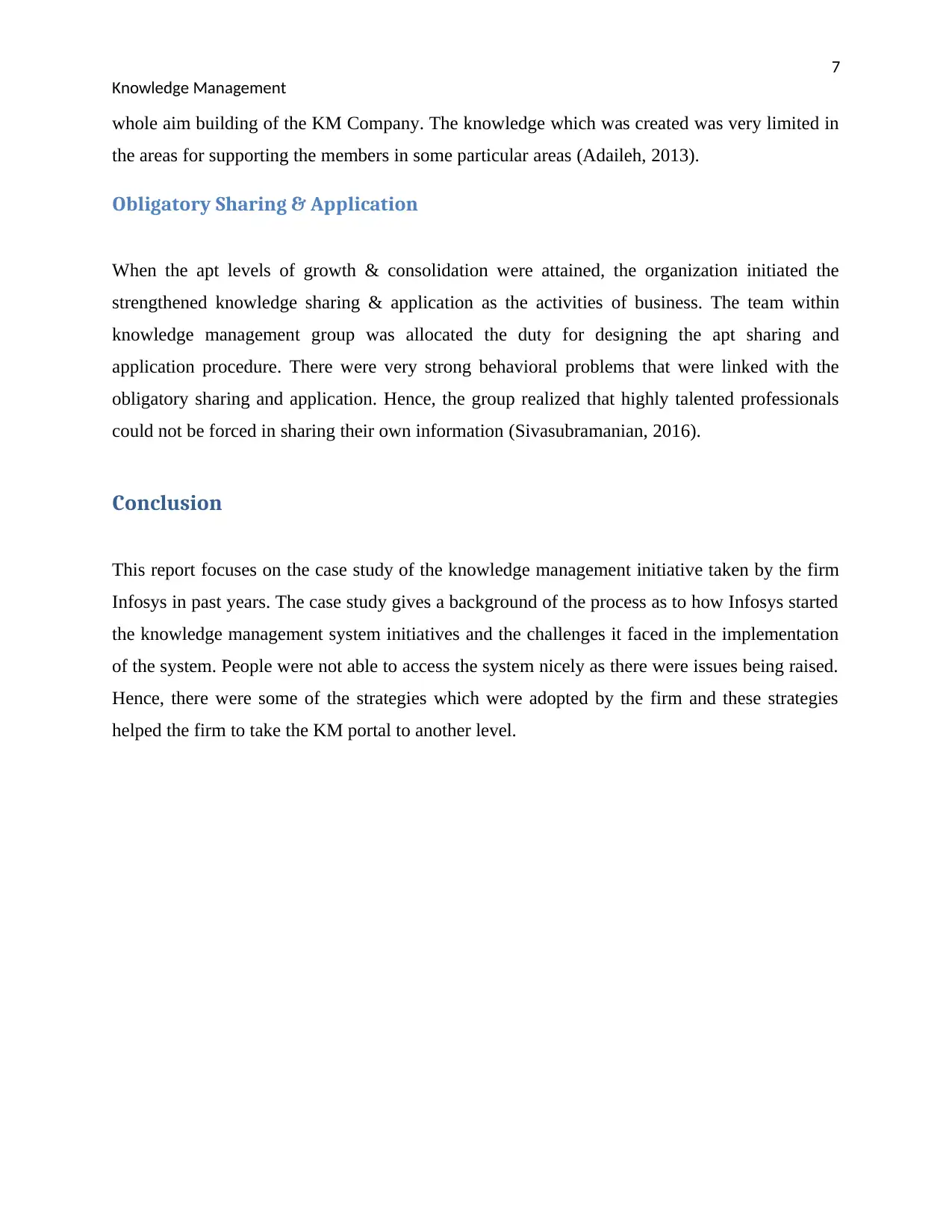
7
Knowledge Management
whole aim building of the KM Company. The knowledge which was created was very limited in
the areas for supporting the members in some particular areas (Adaileh, 2013).
Obligatory Sharing & Application
When the apt levels of growth & consolidation were attained, the organization initiated the
strengthened knowledge sharing & application as the activities of business. The team within
knowledge management group was allocated the duty for designing the apt sharing and
application procedure. There were very strong behavioral problems that were linked with the
obligatory sharing and application. Hence, the group realized that highly talented professionals
could not be forced in sharing their own information (Sivasubramanian, 2016).
Conclusion
This report focuses on the case study of the knowledge management initiative taken by the firm
Infosys in past years. The case study gives a background of the process as to how Infosys started
the knowledge management system initiatives and the challenges it faced in the implementation
of the system. People were not able to access the system nicely as there were issues being raised.
Hence, there were some of the strategies which were adopted by the firm and these strategies
helped the firm to take the KM portal to another level.
Knowledge Management
whole aim building of the KM Company. The knowledge which was created was very limited in
the areas for supporting the members in some particular areas (Adaileh, 2013).
Obligatory Sharing & Application
When the apt levels of growth & consolidation were attained, the organization initiated the
strengthened knowledge sharing & application as the activities of business. The team within
knowledge management group was allocated the duty for designing the apt sharing and
application procedure. There were very strong behavioral problems that were linked with the
obligatory sharing and application. Hence, the group realized that highly talented professionals
could not be forced in sharing their own information (Sivasubramanian, 2016).
Conclusion
This report focuses on the case study of the knowledge management initiative taken by the firm
Infosys in past years. The case study gives a background of the process as to how Infosys started
the knowledge management system initiatives and the challenges it faced in the implementation
of the system. People were not able to access the system nicely as there were issues being raised.
Hence, there were some of the strategies which were adopted by the firm and these strategies
helped the firm to take the KM portal to another level.
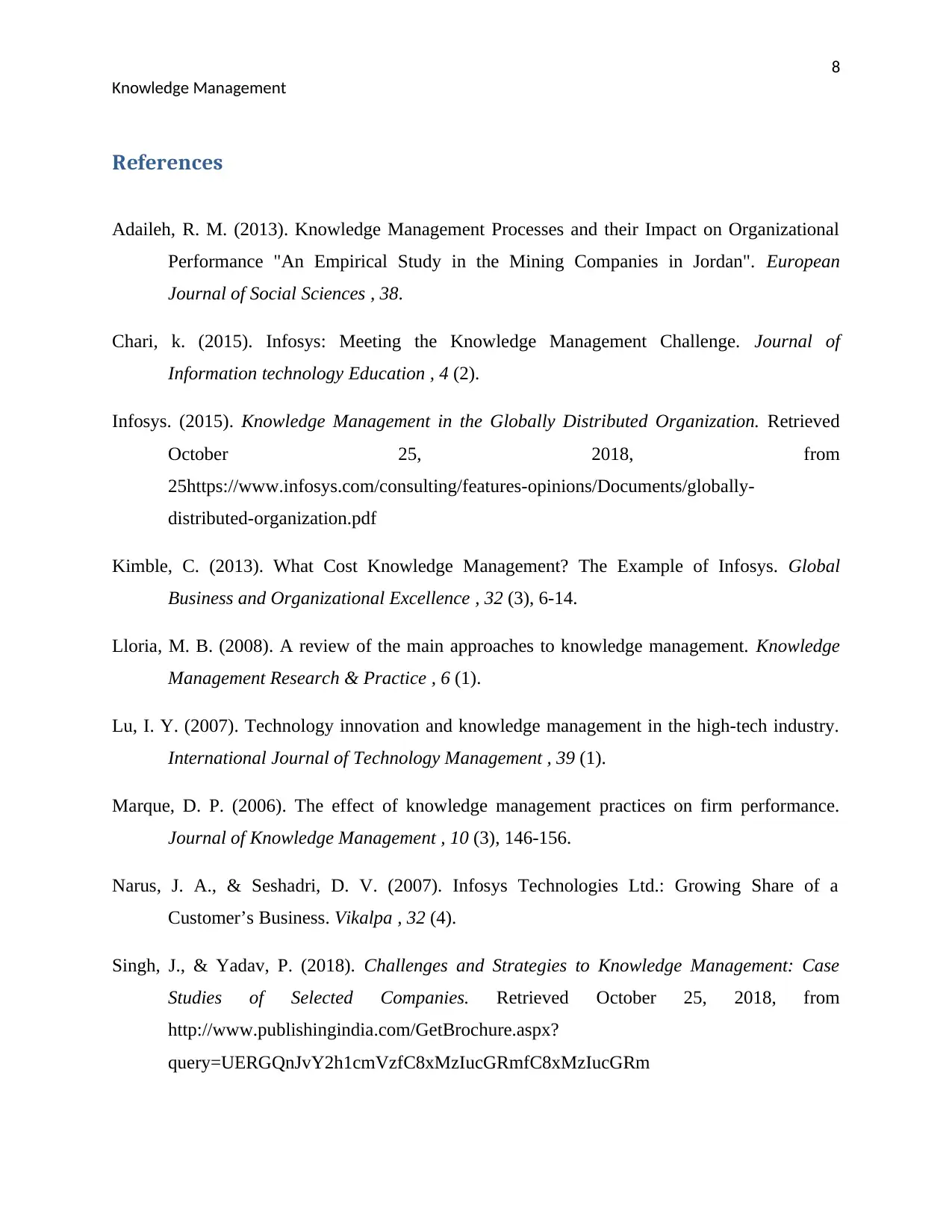
8
Knowledge Management
References
Adaileh, R. M. (2013). Knowledge Management Processes and their Impact on Organizational
Performance "An Empirical Study in the Mining Companies in Jordan". European
Journal of Social Sciences , 38.
Chari, k. (2015). Infosys: Meeting the Knowledge Management Challenge. Journal of
Information technology Education , 4 (2).
Infosys. (2015). Knowledge Management in the Globally Distributed Organization. Retrieved
October 25, 2018, from
25https://www.infosys.com/consulting/features-opinions/Documents/globally-
distributed-organization.pdf
Kimble, C. (2013). What Cost Knowledge Management? The Example of Infosys. Global
Business and Organizational Excellence , 32 (3), 6-14.
Lloria, M. B. (2008). A review of the main approaches to knowledge management. Knowledge
Management Research & Practice , 6 (1).
Lu, I. Y. (2007). Technology innovation and knowledge management in the high-tech industry.
International Journal of Technology Management , 39 (1).
Marque, D. P. (2006). The effect of knowledge management practices on firm performance.
Journal of Knowledge Management , 10 (3), 146-156.
Narus, J. A., & Seshadri, D. V. (2007). Infosys Technologies Ltd.: Growing Share of a
Customer’s Business. Vikalpa , 32 (4).
Singh, J., & Yadav, P. (2018). Challenges and Strategies to Knowledge Management: Case
Studies of Selected Companies. Retrieved October 25, 2018, from
http://www.publishingindia.com/GetBrochure.aspx?
query=UERGQnJvY2h1cmVzfC8xMzIucGRmfC8xMzIucGRm
Knowledge Management
References
Adaileh, R. M. (2013). Knowledge Management Processes and their Impact on Organizational
Performance "An Empirical Study in the Mining Companies in Jordan". European
Journal of Social Sciences , 38.
Chari, k. (2015). Infosys: Meeting the Knowledge Management Challenge. Journal of
Information technology Education , 4 (2).
Infosys. (2015). Knowledge Management in the Globally Distributed Organization. Retrieved
October 25, 2018, from
25https://www.infosys.com/consulting/features-opinions/Documents/globally-
distributed-organization.pdf
Kimble, C. (2013). What Cost Knowledge Management? The Example of Infosys. Global
Business and Organizational Excellence , 32 (3), 6-14.
Lloria, M. B. (2008). A review of the main approaches to knowledge management. Knowledge
Management Research & Practice , 6 (1).
Lu, I. Y. (2007). Technology innovation and knowledge management in the high-tech industry.
International Journal of Technology Management , 39 (1).
Marque, D. P. (2006). The effect of knowledge management practices on firm performance.
Journal of Knowledge Management , 10 (3), 146-156.
Narus, J. A., & Seshadri, D. V. (2007). Infosys Technologies Ltd.: Growing Share of a
Customer’s Business. Vikalpa , 32 (4).
Singh, J., & Yadav, P. (2018). Challenges and Strategies to Knowledge Management: Case
Studies of Selected Companies. Retrieved October 25, 2018, from
http://www.publishingindia.com/GetBrochure.aspx?
query=UERGQnJvY2h1cmVzfC8xMzIucGRmfC8xMzIucGRm
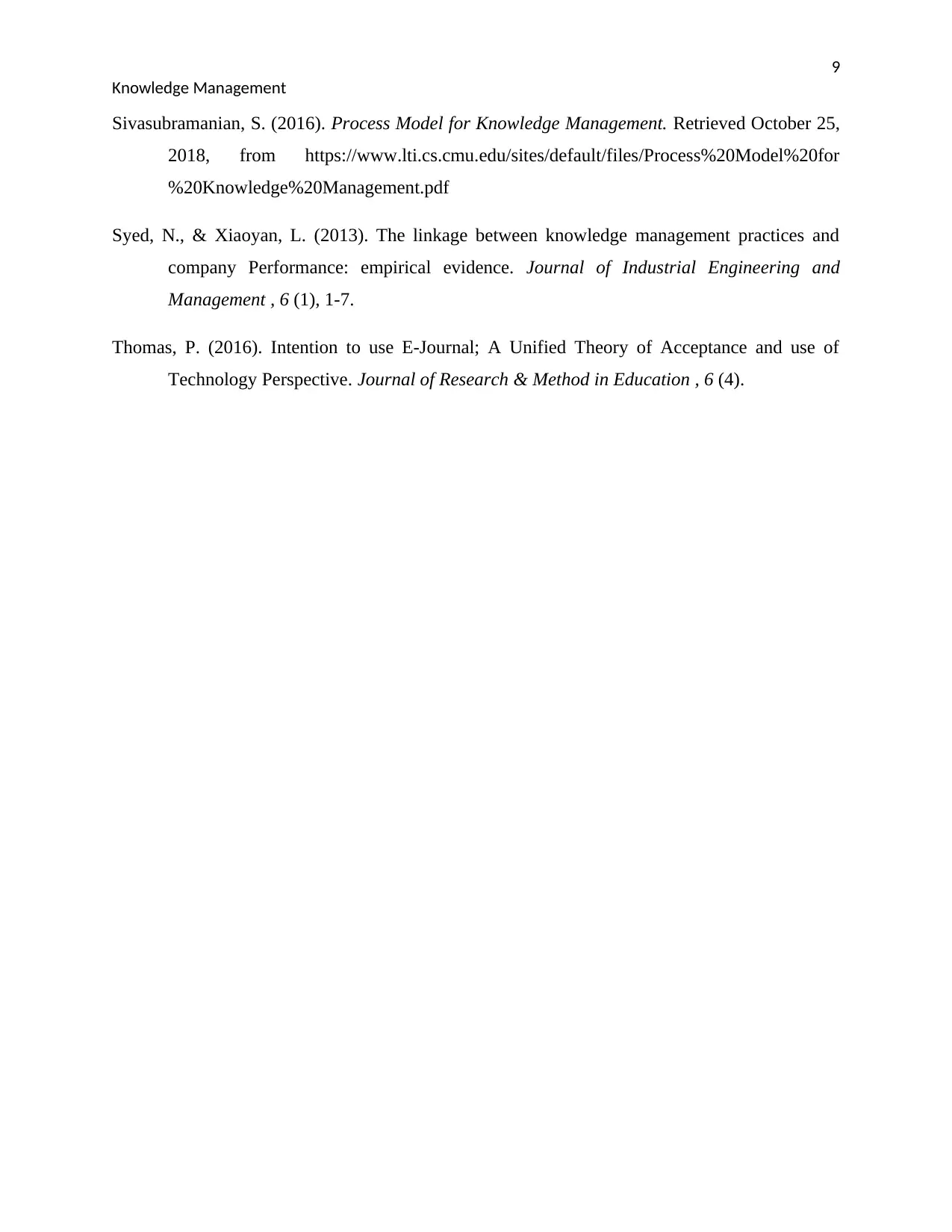
9
Knowledge Management
Sivasubramanian, S. (2016). Process Model for Knowledge Management. Retrieved October 25,
2018, from https://www.lti.cs.cmu.edu/sites/default/files/Process%20Model%20for
%20Knowledge%20Management.pdf
Syed, N., & Xiaoyan, L. (2013). The linkage between knowledge management practices and
company Performance: empirical evidence. Journal of Industrial Engineering and
Management , 6 (1), 1-7.
Thomas, P. (2016). Intention to use E-Journal; A Unified Theory of Acceptance and use of
Technology Perspective. Journal of Research & Method in Education , 6 (4).
Knowledge Management
Sivasubramanian, S. (2016). Process Model for Knowledge Management. Retrieved October 25,
2018, from https://www.lti.cs.cmu.edu/sites/default/files/Process%20Model%20for
%20Knowledge%20Management.pdf
Syed, N., & Xiaoyan, L. (2013). The linkage between knowledge management practices and
company Performance: empirical evidence. Journal of Industrial Engineering and
Management , 6 (1), 1-7.
Thomas, P. (2016). Intention to use E-Journal; A Unified Theory of Acceptance and use of
Technology Perspective. Journal of Research & Method in Education , 6 (4).
1 out of 10
Your All-in-One AI-Powered Toolkit for Academic Success.
+13062052269
info@desklib.com
Available 24*7 on WhatsApp / Email
![[object Object]](/_next/static/media/star-bottom.7253800d.svg)
Unlock your academic potential
© 2024 | Zucol Services PVT LTD | All rights reserved.


